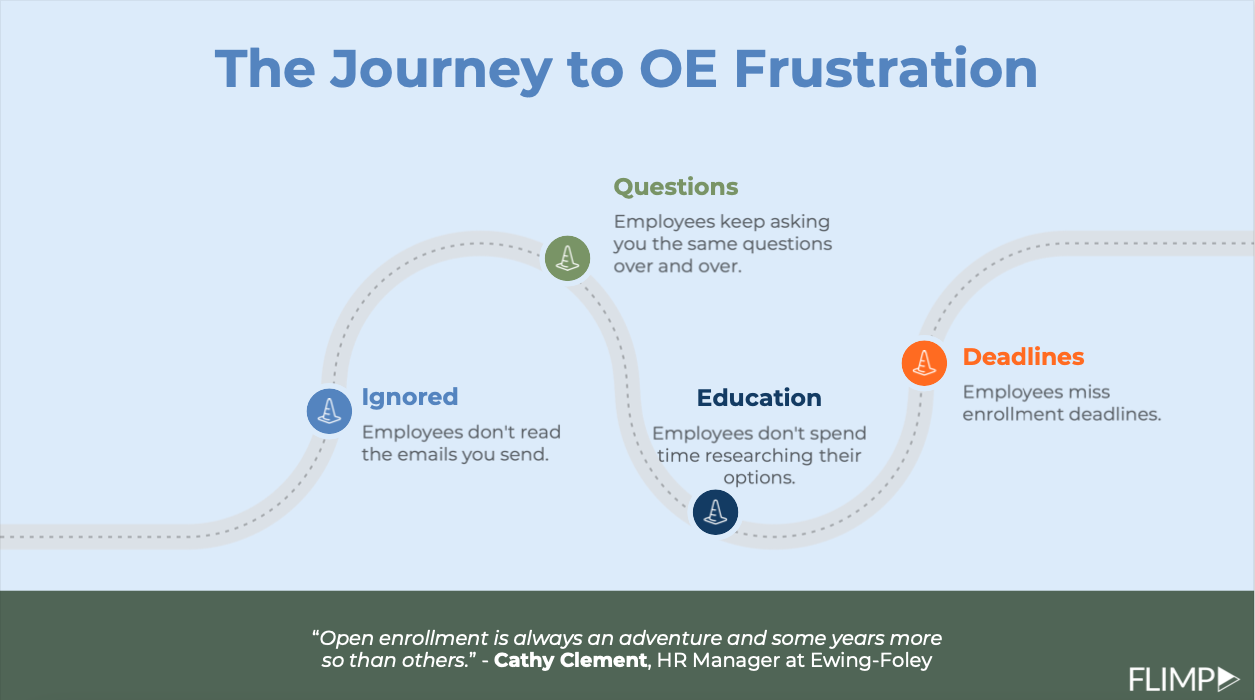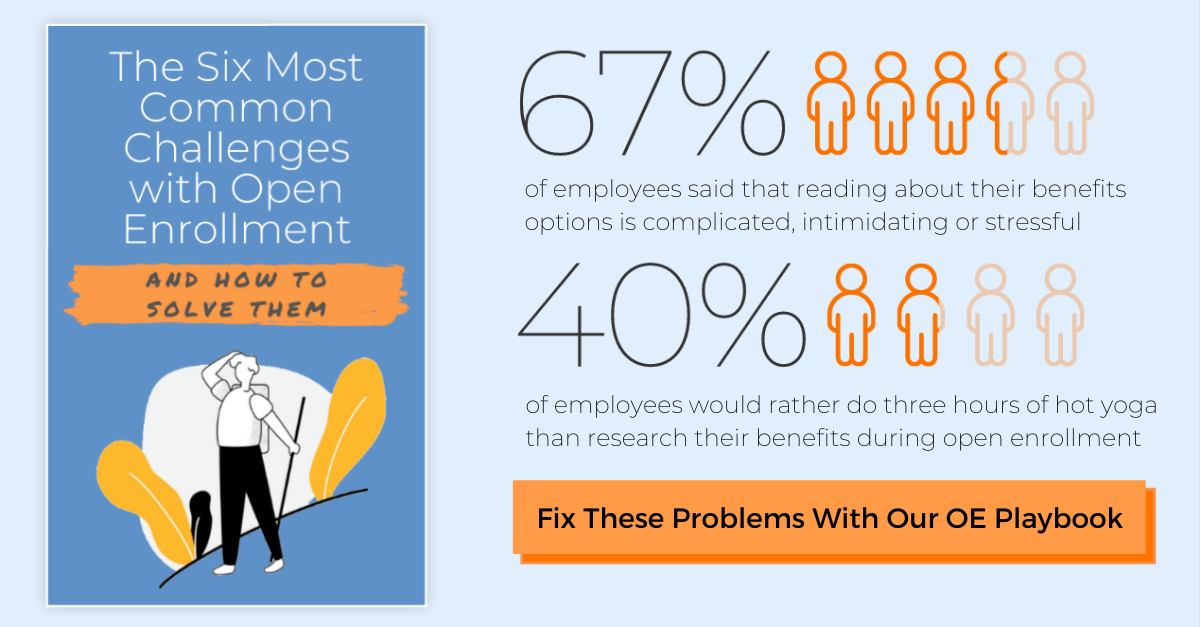Some years, open enrollment goes smoothly. Other years, it definitely doesn’t. If you’re dealing with an active enrollment year, then you know the importance of having a successful open enrollment.
So how can you do that? It starts with understanding the reasons why OE fails. In our research, our team uncovered the six most common challenges, and we’ve also provided some practical and actionable solutions to each.
Challenge #1: Employees find OE intimidating, stressful, confusing, and complicated to navigate.
When it comes to open enrollment, employees often finish the process with more questions than when they started. They’re finding it increasingly difficult to interpret their benefits plans and, more often than not, they don’t fully understand what they signed up for.
Solution: Keep It Super Simple (KISS)
Employees are anxious because they worry about the complexity of benefits research. Your mission is to keep it so simple that employees notice right away that this experience is different.
That requires digging through each of the stressful or confusing parts of open enrollment and improving them. Here are a couple of areas that come to mind:
- Plan documents are confusing. Use video or short- form FAQ documents to demystify the options.
- Employees struggle to choose between multiple plans for their unique situation. Offer an easy-to-use benefits decision-support tool.
Challenge #2: Employees often don’t know the basics, like where to go to learn about their plan options.
Emails get lost in inboxes and are often overlooked during the workday, while stacks of informational pamphlets and papers get lost in the clutter. Employees get overwhelmed with their options and where to find all the information they need in order to learn about and choose the right benefits plan. This search for information intensifies as the deadline for enrollment approaches.
Solution: Centralize the Information
You have to find a way to centralize the information into one place, creating frictionless access to important documents, forms, PDFs, etc. Here are some ways that other employers are handling this across HR teams:
- Create open enrollment microsites that centralize all the information on a few easy-to-navigate webpages.
- Share information via internal wikis or intranets.
Challenge #3: Employees don’t read your benefits-related materials and communications
How many times do you get asked the same question over and over? How many times do you think to yourself, “I’ve already sent this information in an email…”?
It turns out, email, hour-long presentations, and long benefits guides aren’t engaging enough to catch the attention of most employees.
They want their employers to communicate about benefits in a way that’s quick, straightforward, and easy to understand. Handing them stacks of paperwork before the enrollment period begins will leave them overwhelmed and confused.
Solution: Communicate with Short, Visual Content
Employees need multiple opportunities to engage with benefits information prior to the deadline. Make sure you plan your communications several weeks out and create short, engaging content that even the busiest staffer will read. Here’s how Flimp helps you deliver extremely high engagement and enrollment:
- Develop visual content, like videos and graphics, which are proven to improve understanding and awareness.
- Inform employees about their benefits throughout the year. Deliver information gradually, in easy-to-digest pieces, and focus on reviewing one benefit at a time.
- Create a benefits-communication strategy.
- Use text messaging and QR codes to get important updates and information to your employees quickly and make it easily accessible on any device. Take your message to them.
Challenge #4: HR teams have the same meetings, the same presentations, and answer the same questions repeatedly.
It’s exhausting for HR teams to have the same meetings, give the same presentations, and answer the same questions over and over during OE.
Especially as you head down the final stretch to deadline day.
While HR and benefits managers are incredibly patient, it’s frustrating when time is unnecessarily wasted answering questions on the same topic over and over.
Solution: Support a Self-Service Model
One of the biggest reasons that HR teams face redundant questions and meetings is because they center themselves in the process: they give presentations, set up one-on-ones, and position themselves as the go-to source for information around open enrollment.
But employees also want an on-demand experience. The best HR teams today are listening to employees and supporting a self-guided model for enrollment. They’re offering:
- Decision support. Provide trustworthy decision- support tools during OE so that employees can opt for a self-help solution to choose the plan that makes the most sense for them.
- Video content. Provide helpful, short videos for employees to learn about and better understand complicated benefits topics.
Challenge #5: HR teams pay a real price when employees miss their enrollment deadlines.
When employees miss OE deadlines, because they ignored benefits communications, it has a direct effect on HR teams as well. It results in added administrative burdens and unhappy or unproductive employees. Sometimes employees even have coverage gaps, and this can have disastrous consequences.
Not to mention increased cost to the company. These are the kinds of problems CFOs pay attention to and not the kind of attention HR teams want from senior leadership.
Solution: Use Employee Texting
We know that employees often don’t open emails (20% open rate), but they absolutely do open text messages. The average text message has a 98% open rate.
- Whether you’re announcing new healthcare plans, sending educational content, pushing employees to meet their benefits-enrollment deadlines, sending compliance-critical documents, or communicating emergency information, some messages are too important to just send an email. Workforce texting is a proven solution to drive engagement, compliance, and urgency.
Challenge #6: HR teams struggle to get their employee population to migrate to HDHPs.
For a wide swath of employees, HDHPs are—by far—the best plan for their needs. But they don’t sound that way.
Employees are generally concerned and confused by the differences in HDHPs. With the proper education and communication strategies in place, HR teams can more effectively increase adoption of HDHPs.
Solution: Use Decision Support to Improve HDHP Migration
For many employees, an HDHP is the right decision. A benefits decision-support tool excels at finding which of those employees are a match for HDHP and laying out the financial case for why it’s the right decision for them.
You can further support the decision-making process with:
- Virtual Benefits Fairs
- Visual Content
- HR/Employee Videos
Want to learn more? Download the entire playbook.
In our open enrollment playbook, you’ll learn even more about why OE fails, how you can fix it, and how we can help. And it even includes some unique statistics we uncovered.







